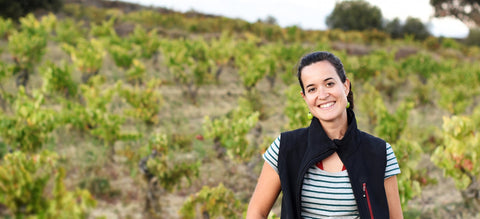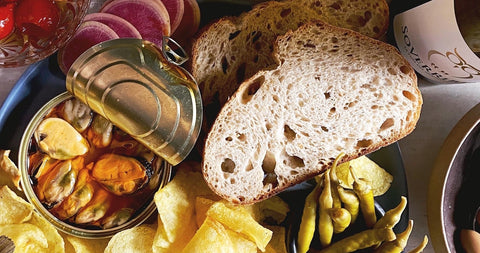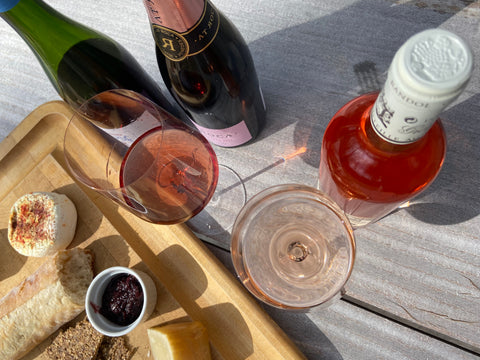Sandra Bravo is still in her thirties but one of the most exciting producers in the Rioja region. She was born in Logroño, the region’s capital. Her parents had a small furniture shop, and she had no connections to wine — apart from growing up in the middle of one of the most powerful winemaking regions in Spain. Today, she’s making some of the freshest Rioja wines out there. We’ve called her Rioja Tinto “a pomegranate juice bomb squeezed from gleaming white limestone” that favors freshness over bombacity. She gets this distinct edge by working vineyards high up in the foothills of Sierra de Toloño, away from the big wineries that dominate the more fertile areas. It’s rugged, backbreaking work. But she does it with enthusiasm. In her words, “It was destiny.”
We tasted a few of Sandra’s wines with her recently and talked about her work and journey as a winemaker.

I live in Villabuena de Alava, it's a very small village of 300 people, and that’s where my winery is. It's Rioja Alavesa, in southern Basque country and the northernmost part of Rioja.
Here we are at 650 meters altitude at the highest part, so there's a lot of freshness, but at the same time we're at the foot of the mountain that is called Sierra del Toloño and it's so protected. The environment is so Mediterranean, with all these Mediterranean herbs, there are almonds and melons, and you can really feel it in the wine.
When you walk in the morning in the vineyards first thing that you feel is that north wind, that light, and the smell of the herbs. And this calcareous soil that gives that salty touch to the wines, to the white especially. Sometimes I have to wait until November to harvest, because the conditions can be limiting — older people remember harvesting with the snow.
But it’s very special. In the highest part, there are only 12 people living there. And everyone has the same last name as me. They’re old men, and I'm always learning from them. The knowledge that they have, their resilience, everything.
It's this combination of everything that gives the taste of the wines. I always wanted to make more natural more respectful wines so I'm very focused on the vineyard, and in the cellar, it's minimal intervention. The taste you have in the bottle is the taste you have in the vineyards. I don't follow the rules of Crianza or Riserva, these kinds of old rules from Rioja, and so the wines are fresher and more alive.
Sandra also told us about the challenge of finding people willing to sell their vineyards to her. Of course, large wineries have much more cash on hand to offer older farmers who might be ready to sell. But even if somebody is sitting on a rocky mountain vineyard with centennial vines, they might be tempted to replant it to younger vines with a higher yield. It took her a while to convince some of the older residents of Villabuena to trust her with the future of their vines, but that trust has paid off. She’s converted everything she works with to organics and biodynamics and can see an immediate difference in the health of the soil and the taste of the wines.
At the beginning, it was so hard to find it because there are big wineries and they have money no? And they are first. But because I’m working very old plots you have to do everything by hand, and it's so so hard. I mean the old viticulturists are used to it, but the new generation prefers to use a tractor and see their vineyards from the top in the air-conditioned cab, that's easier, no?
So it's difficult to get the vineyards because viticulturists never sell the land. They just change it for young vineyards or whatever. I was so lucky, I always say it was destiny that I could buy all these vineyards and take care of them.
And I have seen the transition from traditional farming to organic and biodynamic. Sometimes when people ask me, “Do you trust this?” … But I have seen it. I have seen how strong the vineyards have become. For example this summer, it was warm, and they were so strong that the ripening was perfect, and the taste was perfect. Many times we talk about many things and we forget about the taste. That's the most important thing: that we enjoy the wines. And there is a big big difference. The soil becomes so alive again, that when we harvest there are so many insects. But I have to say I'm like a unicorn over there. I try to convince people to make the change but it will take some time.
We tasted Sandra’s Rioja Tinto — a ridiculously juicy Tempranillo that would pair incredibly with Jamon Serrano or Iberico or a Spanish tortilla. This was the first wine she made when she started Sierra de Toloño almost a decade ago. With this cuvée, she’s honed her ability to judge when the grapes are ripe enough to harvest, but not so ripe that they become flabby.
I can decide the date of harvesting only by tasting because the freshness is always there. I learned over the years that the Tempranillo only has a few days where you have that freshness but the tannins are round and make it so yummy. After those days, you totally lose the acidity and it's flat. Before those days, it's too tannic. And if you harvest with those green tannins, it doesn't matter how long it sits in the bottle, it won't change.

We asked Sandra if she sees any changes in Rioja on the whole, and what trends she’s noticed or thinks people should pay attention to in the kinds of wine coming out of the historic region. Her answer was interesting — maybe indicative of something to be excited about, but also a reminder of how important it is to support small estate operations like hers.
There’s an explosion happening. Now it's very funny because big wineries want to be the small wineries. And there are small producers showing up, but the vineyards are so expensive that it’s difficult to get started. I think I will be paying off the vineyards until I die. Buying one vineyard is like buying a house.
She also framed Rioja in a way that opens up the map for further exploration. We’re taught that the region can be classified by Rioja wines can be classified as Rioja Crianza (the youngest and hence freshest), Rioja Reserva (aged for longer, more oaky) and Gran Riserva (aged the longest.) That system relies on oak and age to lend character to the wines. Sandra works outside the system, and envisions a future where wine expresses all the diversity the region has to offer.
Rioja has so many different possibilities. It's not just three areas. Every valley has different tastes, different possibilities, and different varieties. It's like one world in one region. It's artisan wines and wines that talk about their region. Of course, I'm Rioja because Rioja is a thousand different kind of wines. And that's the future no? Making more artisanal wines, farming biodynamically. There are only a few of us doing it. But that's the way.



